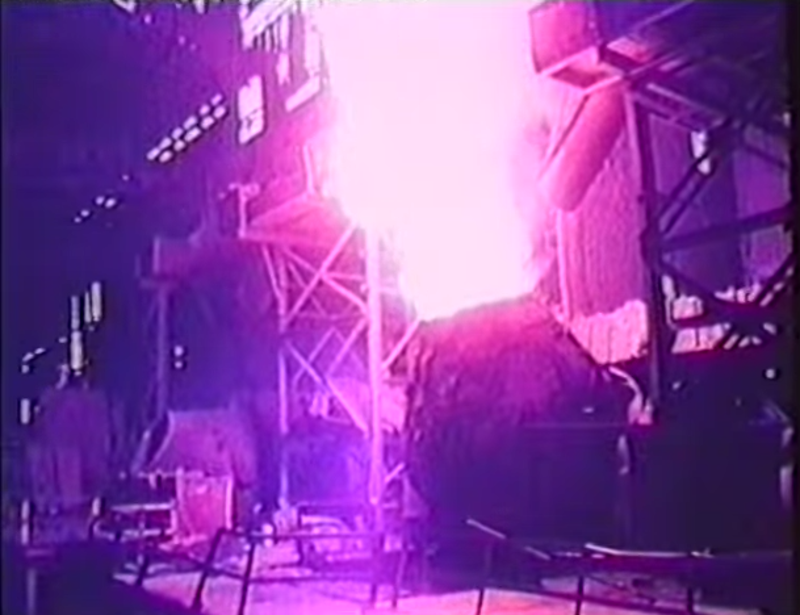Here’s a rose-colored look into the steelworks at Workington, Cumbria in northern England. At the time of filming in 1974, this plant had been manufacturing steel nonstop for 102 years using the Bessemer process. [Sir Henry Bessemer]’s method for turning pig iron into steel was a great boon to industry because it made production faster and more cost-effective.
 More importantly, [Bessemer]’s process resulted in steel that was ten times stronger than that made with the crucible-steel method. Basically, oxygen is blown through molten iron to burn out the impurities. The silicon and manganese burn first, adding more heat on top of what the oxygen brings. As the temperature rises to 1600°C, the converter gently rocks back and forth. From its mouth come showers of sparks and a flame that burns with an “eye-searing intensity”. Once the blow stage is complete, the steel is poured into ingot molds. The average ingot weighs four tons, although the largest mold holds six tons. The ingots are kept warm until they are made into rail.
More importantly, [Bessemer]’s process resulted in steel that was ten times stronger than that made with the crucible-steel method. Basically, oxygen is blown through molten iron to burn out the impurities. The silicon and manganese burn first, adding more heat on top of what the oxygen brings. As the temperature rises to 1600°C, the converter gently rocks back and forth. From its mouth come showers of sparks and a flame that burns with an “eye-searing intensity”. Once the blow stage is complete, the steel is poured into ingot molds. The average ingot weighs four tons, although the largest mold holds six tons. The ingots are kept warm until they are made into rail.
The foreman explains that Workington Works would soon be switching over to a more modern process. As it was, Workington ran a pair of Bessemer converters on a 40-minute schedule, ensuring constant steel production from ore to rail. Between 1872 and 1974, these converters created an estimated 25 million metric tons of steel.
[Thanks for the tip, Chris!]
Retrotechtacular is a weekly column featuring hacks, technology, and kitsch from ages of yore. Help keep it fresh by sending in your ideas for future installments.















Spectacular! +1 to badass at 6:30 smoking a cigarette. “goggles are for sissies!”
I guess if you’re inhaling all that fume, ciggies are the least of your worries. (c:
Everyone thinks safety features are for sissies until they have an accident. Speaking as a welder with some big scars.
I remember going camping with a welder who used to pick up pots out of the fire with his bare hands saying he was tough. I just kept thinking: he can’t feel the pain but isn’t it still cooking his flesh?
If the calluses on his hands was thick enough, he definitely wouldn’t feel it, and the heat would probably just reinforce callus creation. I don’t have my charts ( :P ), but I can’t imagine that the few seconds it would take to transfer a pot out of the fire would transfer enough heat to cook flesh…
Like coal walkers I guess?
i’m an amateur welder and I stick my right hand in boiling water every morning to pull boiled eggs out.
The Bessemer process is quite interesting for a bunch of reasons; really, all of historical metallurgy is damn interesting.
The process really works by oxidizing or “burning” out the carbon that is absorbed into the iron, as the video mentions. Just like you could burn a block of graphite or a lump of coal, this is oxygen reacting with carbon. This is an exothermic reaction, so blowing the air or oxygen into the molten metal actually causes it to continue heating, rather than cooling and solidifying. Thus the increase in temperature during the process, and no need to continue burning fuel to heat the metal.
You can see the same effect when torch-cutting steel. Any welder can tell you how this works with an oxy-acetylene cutting torch: after starting the cut you can actually switch off the gas and cut with *just* the oxygen, under the right conditions.
The produced steel is not really “ten times stronger”, it is just a very different product that is far more useful. When steel melts, it can absorb a lot of carbon, which will then be trapped in the structure when it solidifies. Carbon content of 3-4% will make “cast iron”. Very stiff, but also brittle, so not suitable for high loading. Not really workable at all, in a state other than liquid casting.
The other end of the spectrum is zero or near zero carbon content, often called “wrought iron”. Much more malleable, but also much less stiff. Lower stress to failure, but it won’t shatter or fracture at small deflection, like cast iron. Very good for working, since it can be hammer, rolled, squished, welded, etc.
“Steel” is iron with a small carbon content, usually in the 0.8 – 1.5% range, to balance and mix the benefits of strength and flexibility. The Bessemer process was a big deal since it allowed the control of carbon content by timing how long the conversion was done; more blowing burned away more carbon, and the blowing could be stopped at any point.
Also, Bessemer’s autobiography is online, in which the process is detailed, with lots of good pictures to example the brittle/malleable properties of the product:
https://archive.org/details/sirhenrybessemer00bessuoft
Very interesting comment, thanks!
+1 cheers
I just started into Bessemer’s autobiography at the link above – a fascinating read.
“The Bessemer process was a big deal since it allowed the control of carbon content by timing how long the conversion was done;”
That was the original idea, but it proved impossible to determine how much carbon there would be in the iron to start with since it was not a homogenous mix. The output would be anyone’s guess and the process never worked properly.
So what they did is burn off -all- the carbon and then add it back in.
It was actually the open-hearth (Siemens-Martin process) that allowed precise timing of conversion. The Bessemer process was fast: blasting the melt for 20 minutes removed nearly all the impurities, whereas the open hearth converter operated for 8-9 hours per batch, allowing chemical analysis of the metal to decide when to stop.
The open-hearth method largely replaced the Bessemer process for one crucial difference: it could re-use scrap metal, and it didn’t introduce nitrogen into the melt, so the result was cheaper and less brittle steel. The Siemens-Martin process uses iron oxide (rust) instead of air to provide the oxygen.
Bessemer started out using air to feed his converter. This was later refined by using oxygen into the Basic Oxygen Furnace.
If i’m not mistaken it’s “tonnes” not tons.
1 ton = 2240 lb (907 kg) (an imperial measurement)
1 tonne = 1000 kg (a metric measurement)
A ‘tonne’ is a metric ton, 1000 kg. A ‘tonne’ may not be familiar to some people in countries where imperial or ‘customary’ measurements remain in use, hence the use of ‘metric ton’ to distinguish the metric version. It is redundant to say ‘metric tonne’.
A ton can be a long ton (2240 lb or 1016 kg) or a short ton, (2000 lb or 910 kg).
Look up ‘ton’ and ‘tonne’ in Wikipedia for a more detailed explanation.
Oops, 2000 lb = 907 kg. My bad.
One day, the US will go metric. Maybe even before I die.
You make a compelling argument. I, for one, am hoping that Brussels mandates that only French shall be spoken.
“A ‘tonne’ may not be familiar to some people in countries where imperial or ‘customary’ measurements remain in use” – yeah like all three of them (USA, Liberia, and Myanmar) – and as a result we must write metric ton instead of tonne? Wouldn’t it be easier if those few people could just look up tonne on Google?
Interesting video. The closing of that furnace must have been why a friend’s family emigrated from Workington in 1974.
I don’t live too far from the plant, it used to be a pretty incredible place. Weird seeing it on Hackaday though
“the climax of the blow” huhuhuhuhuh.
I was a metallurgist at Moss Bay when they blew them out in 1974.
The reason that the Bessemers at Workington were successful, was the local Beckermet ore was low in Phosphorus, thus the steel was not so brittle. The blast was largely air (not oxygen-that was BOF), so it introduced Nitrogen onto the steel which gave it more strength. This was ideal for the rail steels produced. After the local ores were consumed, the plant continued to operate on imported low P ores, from Australia and Norway. After 1974, the Blast furnaces continued to make foundry irons, while rolling rails from steel brought from Teesside, then Scunthorpe.
Coincidentally in late 1970s I was a metallurgist at the steelworks in Port Kembla, Australia. A piece of broken Moss Bay rail came in for analysis and was allocated to me. Micro analysis showed the banding characteristics of high phosphorus steel and it was immediately clear it had been produced by the Bessemer process. I still have the sample in my study as a reminder.